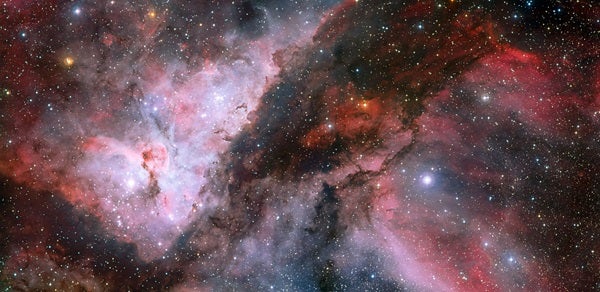A spectacular new image from the European Southern Observatory’s (ESO) Wide Field Imager at the La Silla Observatory in Chile shows the brilliant and unusual star WR 22 and its colorful surroundings. WR 22 is a hot and bright star that is shedding its atmosphere into space at a rate many millions times faster than the Sun. It lies in the outer part of the dramatic Carina Nebula from which it formed.
Massive stars live fast and die young. Some of these stellar beacons have such intense radiation passing through their thick atmospheres late in their lives that they shed material into space many millions times more quickly than relatively sedate stars such as the Sun. These rare, hot and massive objects are known as Wolf-Rayet stars, and one of the most massive ones yet measured is WR 22. It appears at the center of this picture. WR 22 is a member of a double star system and has been measured to have a mass at least 70 times that of the Sun.
WR 22 lies in the southern constellation Carina. Although the star lies over 5,000 light-years from Earth, it is so bright that it just can be faintly seen with the unaided eye under good conditions. WR 22 is one of many exceptionally brilliant stars associated with the beautiful Carina Nebula (NGC 3372). The outer part of this region of star formation in the southern Milky Way forms the colorful backdrop to this image.
The subtle colors of the rich background tapestry are a result of the interactions between the intense ultraviolet radiation coming from hot massive stars, including WR 22, and the vast gas clouds, mostly hydrogen, from which they formed. The central part of this enormous complex of gas and dust lies off the left side of this picture as can be seen in the image.










